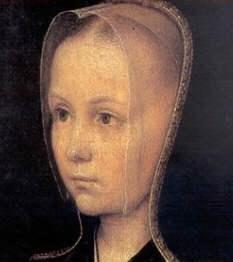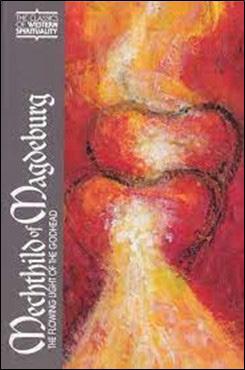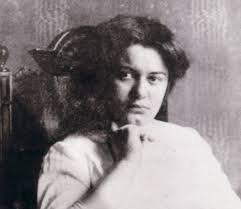
12 minute read
Conversing with God
Lucinda M. Vardey
Lucinda M. Vardey is the editor of With One Accord. For more on her background please visit our website.
In compiling a book of prayers by women I quoted the words of a friend who said that “prayer is a conversation that sustains us.” She gave me one of the best summaries on prayer as it intimates not just an encounter with God but a relationship. A conversation that sustains cannot be a monologue, only a dialogue. And, as in any conversation of meaning and substance, it requires complete honesty, offering the possibilities to share desires and longings as well as lamentations, doubts and confusion. It also requires developing the ability to wait, to listen and to recognize the voice of God when God speaks. There has to be a trust that God’s wisdom, love and care is ready to be revealed in how God deigns all to be, and in God’s own time. And ultimately there needs to be a thirst for intimacy and unity.
As a dialogic activity, prayer as conversation is not widely recognized, explained or recorded, probably because it is more of a feminine prayer. However, there are three women who have provided us with some fine examples: French Beguine, Marguerite Porete (1250-1310), Saxon Cistercian, Mechthild of Magdeburg (1210-1297) and Dominican Tertiary and Doctor of the Church, St. Catherine of Siena (1347-1380).

Their writings take different forms, but share many similar themes. What they all convey is an effort to get to truth in their own specific ways. In his Treatise on the
Love of God St. Francis de Sales wrote that prayer and mystical theology, to which these women contributed, “is nothing else but a conversation in which the soul amorously entertains herself with God concerning his most amiable goodness to unite and join herself thereto.” 1 The aim of such amorous entertainment is to not only be loved by God, but as Mary E. Giles explained, it is to be in a “relational seeing” where “knowledge cannot be gained independent of the experience of the depths of love.” 2
Learning from scripture also required women to bring scripture alive through unique experiences according to the levels of their commitment to prayer. And by recording their experiences, these three women contributed much that could well have influenced the teachings of men and women saints in the later centuries.
Marguerite Porete begins her A Mirror for Simple Souls with a dialogue between Love and the Soul, that moves quickly into a trialogue by introducing Reason that, naturally, has considerable difficulty with the contents of their discourse. Then God and the Church also join in. At one point, Porete notes that slavery comes from doing all from “reason and fear, whereas real freedom can only come from doing things out of faith and love.” Her book charts the progress of the conversation, where she introduces a ladder to perfection, a metaphor Catherine also uses in her Dialogue . Porete www.magdalacolloquy.org has a chapter on “The Dark Night,” which develops a concept introduced at that time by French scholars Thomas of St. Victor and William of Saint-Thierry. She explained that “the truth” in divine relationship is not found in what people say about God compared to what God is, and what God is cannot be said.

Mechthild of Magdeburg defines prayer as a means for transforming the heart. She writes that it makes “an embittered heart mellow, a sad heart joyful, a foolish heart wise, a timid heart bold, a weak heart strong, a blind heart clear-seeing, a cold heart ardent. It draws God who is great into a heart which is small, it drives the hungry soul up to the fullness of God.” 3 She compiled The Flowing Light of the Godhead (a collection of visions, revelations, thoughts and letters) “out of God’s heart and mouth” between 1250-1264. She asks God why God created the soul and the answer is “From the necessity of love” explaining that “God has enough of all good things save of intercourse with the soul; of that God can never have enough.”
Mechthild’s prayer takes the form of gazing at God as God and the soul are in dialogue. Like Marguerite Porete, other aspects enter into the conversation, “Understanding” being one of them. At the end of these dialogues, every woman comes to experience a unity with the Trinity. Mechtild writes:-
“Lord and heavenly Father, You are my heart!
Lord Jesus Christ, You are my body!
Lord Holy Spirit, You are my breath!
Lord Holy Trinity, You are my only refuge and my everlasting Peace.” 4
St. Bernard of Clairvaux taught that the contemplative must bring back from intercourse with God, strength and food for other souls and this can be evidenced in St. Catherine of Siena’s complex work simply entitled The Dialogue.
The Dialogue
While Marguerite Porete’s and Mechthild of Magdeburg’s books model a dialectic between allegories, Catherine’s structure is composed of questions directed to God and God’s responses. Over the course of its writing (purported to be about a year) she gains knowledge and understanding of the truth, love of God and neighbour, the workings of Divine Providence, the bridge (or ladder) up the body of Christ as a way to truth, the five kinds of tears that correspond to the stages of the soul, revelations of the “sacramental heart” (the mystical body of Holy Church) and obedience to the example of Jesus. The Dialogue’s translator, Suzanne Noffke O.P., describes the whole book as “a great tapestry to which Catherine adds stitch upon stitch until she is satisfied that she has communicated all she can of what she has learned of the way of God. It is not so much a treatise to be read as it is a conversation to be entered into.”
Our entering into Catherine’s discourse opens us to the particulars of her relationship with God as well as the wisdom and moral teaching God reveals to her. God addresses her at different times as “dearest daughter, “gentle daughter,” “beloved daughter” and “sweetest daughter,” and identifies Godself as “the fire that purifies the soul.” On the practice of prayer, God warns that if the whole purpose of vocal prayer is based on the recitation of many words—a “multitude of psalms” and “a great many Our Fathers”—it will not please God nor bear much fruit.5 God warns that abandoning vocal prayer for mental prayer is not advised either: “A person has to walk step by step” because the soul is “imperfect before she is perfect” so her prayer is imperfect as well.6 God advocates that vocal and mental prayer include concentrating on God’s love and God’s mercy for sin, allowing for greater self-knowledge. And when someone who prays “senses her spirit ready for my visitation” God says she “ought to abandon vocal prayer.”7
God summarizes that perfect prayer is as the soul’s “mother” and is reached “not with many words but with loving desire,”8 and this prayer includes doing good to your neighbours by “word or deed” explaining that “loving charity” is “continual prayer.”9
Catherine offers prayers of insight and gratitude throughout her text, for the wisdom gained and in thanksgiving for God’s guidance. The God who speaks to Catherine has a voice of clarity, firmness and directness. God wants a soul to only hope in God and not in oneself, not to serve two masters, citing that the world “has nothing in common with me, nor I with it.”10 God adds “and because none of you are stable in this life but are continually changing until you reach your final stable state, I am constantly providing for what you need at any given time.”11 God assures Catherine that God “seasons everything” requiring her to hold all things in reverence “disgrace as well as comfort” because “whatever I do to provide for the body is done for the good of the soul, to make her grow in the light of faith, to make her trust in me and give up trusting in herself, and to make her see and know that I am who I am and that I can and will and know how to assist her in her need and save her.” 12
In her final prayer St. Catherine addresses the Trinity as light, as a sea that nourishes the soul “for when I look into this mirror (of water) holding it in the hand of love, it shows me myself, as your creation, in you, and you in me through the union you have brought about of the Godhead with our humanity.”13
Notes
1 St. Francis de Sales Treatise of Divine Love trans. Rev. Henry Benedict Mackey OSB (Ill, Rockford, Tan Books, 1997) p. 233.
2 Quoted in The Flowering of the Soul: A Book of Prayers by Women ed. Lucinda Vardey (NY, Ballantine, 1999) p. 358.
3 Mechthild of Magdeburg The Flowing Light of the Godhead trans. Lucy Menzies (CT, Martino Pub. 2012) p. 136.
4 ibid p. 132.
5 Catherine of Siena: The Dialogue trans. Suzanne Noffke OP (NY, Mahwah, Paulist Press, l980) p. 124.
6 ibid
7 The Dialogue p. 126.
8 ibid www.magdalacolloquy.org
9 as above p. 172.
10 The Dialogue p. 281.
11 as above p. 282.
12 as above p. 293.
13 as above p. 336.
Kimberley Morton lives and works in Toronto. She has had a varied career in marketing, advertising and business development. A longstanding parishioner of St. Basil’s Catholic Parish, she has been involved in its various ministries including serving the homeless in the “Out of the Cold” programme, and accompanying those who are converting to Catholicism in the Rite of Catholic Initiation for Adults. She has also served on the Parish Council, is a founding member of the Magdala Conciliary and a member of the lay community, the Contemplative Women of St. Anne.
Praying in Communion
Kimberley Morton

In my life as a Protestant I was taught to believe that the saints were in competition with God for our prayers and glory; thus they never played a role in my life or faith. Since becoming Catholic a new ‘group of friends’ have been revealed to me in the saints. I now understand that they do not, by any means, detract from God’s glory; in fact the opposite is true. God’s glory is magnified through their lives, words and sacrifices.
My conversion to the Church happened very quickly in the summer of 2013. I was in a new relationship with a wonderful man I loved deeply and had decided to start attending Mass with him (of my own accord and with a lot of curiosity). I was becoming aware of the reality of ‘the grace of God’ and I very soon found myself saying ‘yes’ to another kind of relationship; a relationship with Jesus. Not satisfied with prayers by rote, I wanted to balance my need for structured prayer with my desire for dialogue with God.
I became obsessed with the story of the woman at the well and her invitation to relationship with Jesus via the living water “…a spring of water gushing up to eternal life” (John 4.14). Her life and experience really spoke to me, and I felt a kinship not only with her suffering and isolation but with her instantaneous conversion. This opened a door for me to the great women of the bible and the saints. I thought I could find my evolving story in their lives and example, and by their suffering and wisdom transform myself so that my conversion would be ‘done.’
Of course it wasn’t as easy as that. Conversion isn’t a one-time event, and never a finished product: whether it is to the Catholic faith or within it, it requires me to give all I can at every moment I am invited by Christ to do so.
I take great comfort in reading about the saints, discovering their paths to complete union with God and the insurmountable obstacles each and every one faced. They lived lives to which I can aspire. In the words of St. (Mother) Teresa of Kolkata, “I can do all things you cannot, you can do things I cannot; together we can do great things.”
It’s a joy to be nourished by the saints’ deep love for Jesus. The following women and their stories illustrate for me the gospel truths in a fresh way.
Ven. Nano Nagle, was born in Ireland in 1718 and showed me that nothing is impossible with God’s grace and direction. She lived through the tumultuous times when local Catholics rose against anti-Catholic forces from England, risking her life to minister to young girls who were desiring a Catholic education. Born into a landowning family she had to resort to begging in the slums at night—never tempted to despair of doing good.
Throughout her life of service—Nagle established a religious order as well as a lay missionary society in addition to her schools for educating the inner-city poor— she was beset by difficulties and when close to death told a friend “I think any little labour I have, the Almighty has given me health to go through it; and if I did not make use of it in his service, he may soon deprive me of it.”1
As I approached my confirmation into the Catholic Church in 2015, I pondered which saint’s name to take. I wanted to find a saint with whom I could feel a true kinship, a strong woman filled with grace and love of God and a desire for charity and truth. I found this person in Edith Stein, St. Teresa Benedicta of the Cross.
Born into an observant Jewish family in 1891, Edith was an educator and the first woman to gain a Doctorate in Phenomenology, a branch of Philosophy. She was drawn to the Catholic faith through numerous encounters with Catholics and by reading the autobiography of Saint Teresa of Avila. After teaching in a Dominican school, she was ordained a Carmelite nun in 1933. Edith had a deep sense of responsibility to others and the truths of the cross indicated by her religious name. She believed “when you seek truth, you seek God whether you know it or not.” 2
Edith and her sister Rosa, also a convert, were seized by the Gestapo in Holland and imprisoned in the Westerbork camp, before they were sent to Auschwitz where she and her sister died. Camp survivors testified that she assisted many of the women and children, and all who accompanied her on the freight train to Poland. Edith believed in the dignity of women and living out their feminine genius.
“A saint,” wrote English mystic and writer, Evelyn Underhill, was one who had “a more www.magdalacolloquy.org wonderful contact with the mystery of the Universe, a life of infinite possibility.” She also said that saints supply “the tools of a dynamic love,” a love that is purged of self-interest and made more perfect “at tremendous cost to themselves and with tremendous effect.” Dynamic love is ours to use, “an engine for working with God.”

Spiritual Friends
The saints help me to find balance in my prayer life. How to give, how to receive and how to listen. “One of the themes of feminine spirituality in our age,” wrote Ronda Chervin in her book Treasury of Women Saints, “is the need of men for the spirituality ministry of women, even when men have consecrated themselves to God in religious life. The special charisms of women are complementary to those of men and cannot simply be replaced by a same-sex friendship.” I’m reminded of the Roman noble woman in the 13th century, Blessed Jacoba of Settesoli, who became a close friend of St. Francis of Assisi with whom he regularly stayed when in Rome. He gave her a lamb who followed her to Mass each day and remained by her side as she prayed. He was particularly fond of special cakes she’d cook for him. As he was dying in Assisi, St. Francis called for her to come to him, and bring him the cloths for his burial. She had already intuited that he was in need and came anyway, arriving after his death. This friendship illustrates that even the holiest of men need the comfort and care of women.
Jacoba sought guidance from Francis on how to be charitable but received so much more. She was probably the only woman after St. Clare with whom he ever developed a close relationship. It was when Francis was welcoming “sister death,” he also welcomed “Brother“ Jacoba as he called her, to be the only woman present among his grieving brothers in the monastery.

Author Sr. Chiara Lainati wrote “For it is precisely the prerogative of the saints, as it is of artists of immortal masterpieces, to be alive in every age and always to speak the language of the present.” The lives of the saints are essential for guiding us to holiness, by being in relationship with them, by embracing their friendship, we strive to become one with them in the mystical body of Christ, being led by the examples of their virtues. We are able to be strengthened by their resolve, by requesting their help and, above all, to uniting with them in the service of Jesus, doing our part in our steps to full communion.
Notes
1 Boniface Hanley, ‘For the Poor Alone, The Anthonian (Patterson, N.J.: St. Anthony’s Guild, 1984), pp. 3-29.
2 https://carmelitesofboston.org/history/our-carmelite-saints/st- teresa-benedicta-of-the-cross-edith-stein/





